MTLBE MODULE 3
1/146
Earn XP
Description and Tags
LAWS GOVERNING MEDICAL TECHNOLOGY/ MEDICAL LABORATORY SCIENCE PROFESSIONALS
Name | Mastery | Learn | Test | Matching | Spaced |
|---|
No study sessions yet.
147 Terms
CHED
It is responsible for overseeing Higher Educational Institutions (HEIs)offering degreecourses.
Professional Regulation Commission (PRC)
It is the agency responsible for all the professionals in the country.
P.D. No. 223
Act that created and prescribed the powers and functions of PRC.
PRC ang lingkod ng Bayan: Patuloy na pag-unlad ang tanging hangad: Sa tao at sa lipunan: Serbisyo ang misyon habang buhay
Teknoekonomiko, pang-politikal at sosyo-kultural: Pang akademiko't pangkalusugan: At may moralidad na hinahangaan ng mundo
Propesyonalismo at integridad: Responsibilidad sa bayang nililiyag: Kahusaya't kaalaman: Taglay naming mga Propesyonal
Kahusaya't kaalaman: Taglay naming Propesyonal: Ipagbunyi ang PRC!
PRC Hymn
PRC Vision
(PRC Vision/Mission) The Professional Regulation Commission is the instrument of the Filipino people in securing for the nation a reliable, trustworthy and progressive system of determining the competence of professionals by credible and valid licensure examinations and standards of professional practice that are globally recognized.
PRC Mission
(PRC Vision/Mission) To deliberately, scientifically and consistently determine the competence of professionals through the provision of professional standards and judicious issuance of professional license.
P – rofessionalism and Integrity
R – esponsibility, Unity and Accountability
C – ompetence and Excellence
P – rofessionalism and Integrity
R – esponsibility, Unity and Accountability
C – ompetence and Excellence
Acronym for PRC
R.A. No. 8981
It is known as the PRC Modernization Act of 2000.
December 5, 2000
When was R.A. No. 8981: PRC Modernization Act of 2000 approved?
March 6, 2001
When did the PRC approve the Implementing Rules and Regulations (IRR) of the Provisions of Republic Act No. 8981. (PRC Resolution No. 1 Series of 2001)
Section 2, R.A. 8981
(Section : Act) The state recognizes the important role of professionals in nation-building and towards this end promotes the sustained development of a reservoir of professionals whose competence has been determined by honest and credible licensure examinations and whose standards of professional service and practice are internationally recognized and considered world class brought about by regulatory measures, programs and activities that foster professional growth and advancement.
Professional Regulation Commission
It is attached to the Office of the President of the Philippines for general direction and coordination.
Full-time Chairman
(2) Full-Time Commissioners
Term: 7 years
Composition of PRC (Section 4, R.A. 8981)
Chairman: Hon. Teofilo S. Pilando, Jr.
Commissioners:
Hon. Yolanda D. Reyes
Hon. Jose Y. Cueto, Jr.
Module: Present PRC
40 yrs old
Valid professional license
Familiar with principles and methods of professional regulation and/or licensing
(5) years executive or management experience
(1) of the Commissioners must be a past Chairperson/member of a Professional Regulatory Board (Section 4, R.A. 8981)
Qualifications of PRC members.
Section 7. R.A. 8981
(Section : Act) The powers, functions, and responsibilities of the Commission.
Executive
Quasi-Judicial
Quasi-Legislative
Three general functions of the powers, functions, and responsibilities of the Commission.
Executive
Administers, implements, and enforces the laws and policies with respect to the regulation and licensing of the various professions and occupations, including the enhancement and maintenance of professional and occupational standards and ethics.
Quasi-Judicial
Investigates motu proprio or upon the filing of a verified complaint, any registered professional, any member of the professional regulatory boards, officers and employees under the jurisdiction of the Commission; Issues summons, subpoena and subpoena duces tecum; May hold in contempt erring party or person; May revoke or suspend certificates of registration and professional licenses.
Quasi-Legislative
Formulates rules and policies on professional regulation. Reviews, revises and approves resolutions embodying policies promulgated by the Professional Regulatory Boards.
P - rofessionalism
R - esponsibility
C - redibility
Quality Policy of PRC
Maintains validity, integrity, and credibility of the licensure examinations.
Ensure that only those who complied are admitted to the practice
Prescribing ethical and technical standards
Effective implementation, compliance, and continuous improvement of the Quality Management System
Monitor and evaluate adherence to Key Performance Indicators (KPI)
Quality Objectives of PRC
Section 9 R.A. 8981
(Section : Act) Powers, Functions and Responsibilities of the Various Professional Regulatory Boards.
Sections 7, 8 & 12
Medical Technology Board (MTB) is described in what sections of R.A. 5527?
1970 pursuant to Republic Act 5527: Philippine Medical Technology Act of 1969
When was the Board of Medical Technology created?
Chairman - Dr. Arturo D. Tolentino, Jr.
Members:
Mr. Felix E. Aspre
Ms. Azucena S. J. Vizconde
First Board of Medical technology
September 1970
When was the first examination of Medical technology?
25%
Percentage of passing in the First Medical technology Board Exams.
Philippine Association of Schools of Medical Technology and Hygiene (PASMETH)
Who did the Board established mutual relations with to upgrade the quality of graduates in developing and updating the course syllabi to improve the performance of schools in the licensure examinations?
Chairman: Pathologist
(2) Members: RMT
Term: 3 years
Composition of MTB
Section 7, R.A. 5527
(Section : Act) In case of death, disability, or removal of a member of the Board, his successor shall serve only the balance of his term.
Chairman: Dr. Marilyn A. Cabal-Barza
Member:
Marian M. Tantingco
-vacant-
Module: Present MTB
Section 8, R.A. 5527
(Section : Act) Qualifications of the Chairman and members of the Board of Medical Technology.
Filipino citizen,
Good moral character,
Qualified Pathologist, or a duly registered medical technologist of the Philippines w/ BSMLS/BS Hygiene/Public Health
Been in the practice of Med tech for 10 years,
For the first three years following the approval of this Act, the requirement shall be reduced to five years,
Not a member of the faculty of any medical technology school for at least two (2) years prior to appointment
Qualifications of the Chairman and members of the Board of Medical Technology.
neglect of duty
incompetency
malpractice or unprofessional
unethical
immoral or dishonorable conduct
Any member of the Board may be removed by the President of the Philippines for:
Section 12, R.A. 5527 (Module: Section 13 daw)
(Section : Act) Suspending a member of the MTB.
PRC Res. No. 1 s. 2001, Rule 3
All PRB has the following functions as provided by what PRC Resolution?
Regulate the practice
Monitor the conditions affecting the practice of the profession
Ocular Inspections
Hear and investigate cases
To suspend or revoke certificates of licenses
Prepare, adopt and issue the syllabi or tables of specifications
To prepare an annual report of accomplishments on programs, projects and activities
PRC Res. No. 1 s. 2001, Rule 3: PRB Functions
Online Application
Examination Schedule
Room Assignment
In the e-services, what are under Examinaion eServices?
Initial Registration
I.D. Renewal
Duplicate ID
Certification
In the e-services, what are under Regstration eServices?
Verification of rating
Verification of Licenses
Certification of Passing and Board Rating
In the e-services, what are under OthereServices?
PRC Licensure Examination and Registration Information System (LERIS)
Online application for licensure
PRC Resolution 2002-76
It is is the Revised Guidelines and Procedures in Filing of Applications for Licensure Examinations approved on November 29, 2002.
November 29, 2002
When was PRC Resolution 2002-76: Revised Guidelines and Procedures in Filing of Applications for Licensure Examinations approved?
True
(True or False) Filing of applications for licensure examinations shall be done personally by the applicant-examinee.
False
(True or False) Filing of applications for licensure examinations by mails and universities is alowed.
“FOR BOARD EXAMINATION PURPOSES ONLY”
PRC Res.2004-200 What must be added to the Transcript of Records with special order when applying for licensure examinations?
True
(True or False) Graduates of government schools and institutions/programs accredited by recognized accrediting agencies under the FAAP are exempted from Special Order (SO).
PRC Resolution 1 s. 2001, Rule IV
It mandates that the persons to teach subjects for licensure examinations on all professions must be holders of valid certificates of registration/professional licenses and professional identification cards, or special temporary permits, or a valid certificate of competency for the profession issued by the Commission, and who comply with the other requirements of the CHED.
Starting first semester of SY 2003-2004
When was PRC Resolution 1 s. 2001, Rule IV effective?
All transcript of records for four (4) year tertiary courses which are subject to licensure examinations, shall reflect a certification under oath by the registrar that all the subjects for licensure examinations were taught by persons who are qualified.
Effective January 1, 2009
All transcript of records for five (5) year tertiary courses which are subject to licensure examinations, shall reflect a certification under oath by the registrar that all the subjects for licensure examinations were taught by persons who are qualified
Effective January 1, 2010
Original and photo/xerox copies of Transcript of Records with Special Order (SO) and Date of Graduation with SCANNED PICTURES AND WITH REMARKS “FOR BOARD EXAMINATION PURPOSES ONLY” (PRC Res.2004-200).
(Graduates of government schools and institutions/programs accredited by recognized accrediting agencies under the FAAP are exempted from SO).
Graduates of New Schools/Degree/Programs must submit School Recognition and/or Permit to Operate.
Original and photo/xerox copy of NSO/PSA-issued Birth Certificate in NSO security paper
Original and photo/xerox copies of NSO/PSA-issued Marriage Contract in NSO security paper for married female only
Four (4) passport size colored pictures in white background with complete name tag.
Examination fee of P 900.00
Requirements for the Board Examination.
P900
Examination fee for board exams
Sections 17, R.A. 5527
(Section : Act) It prescribed the scope of the medical technology board examination.
Clinical Chemistry - 20%
Microbiology & Parasitology - 20%
Hematology - 20%
Blood Banking & Serology - 20%
Clinical Microscopy (Urinalysis and other body fluids) - 20%
Medical Technology Laws, Related Laws and its implementing rules, and the Code of Ethics - 10%
Subjects with their respective relative weights in board exam
20%
Percentage of Clinical Chemistry in Board Exam.
20%
Percentage of Microbiology & Parasitology in Board Exam.
20%
Percentage of Hematology in Board Exam.
20%
Percentage of Blood Banking & Serology in Board Exam.
10%
Percentage of Clinical Microscopy (Urinalysis and other body fluids) in Board Exam.
10%
Percentage of Medical Technology Laws, Related Laws and its implementing rules, and the Code of Ethics in Board Exam.
BMT Resolution 1996-15
Resolution that released the Syllabi for, and guidelines in the preparation of questions in the subject of the Medical Technology Licensure Examination.
Clinical Chemistry
Hematology
Blood Banking and Serology
Microbiology and Parasitology
Major Subjects in the Board Exam
Histopathologic techniques
Med. Tech. Laws
Clinical Microscopy
Minor subjects in the Board Exam
“Nice to Know” 10%
“Desirable or Useful to Know 30%
“Must Know” 60%
Topic Classification and Corresponding Percentages in Board Exam
Hard 15%
Average (Moderate) 50%
Easy 35%
Item Classification According to “Difficulty” to and Corresponding Percentage in Board Exam
“Nice to Know”
(Understanding Topic and Item Classification) Are recent advances in technology and historical data of the topic.
“Desirable to Know”
(Understanding Topic and Item Classification) Basic information/concepts/principles
“Must Know”
(Understanding Topic and Item Classification) Basic knowledge and skills of day tday-to-dayo day practice of the.profession
Easy
(Understanding Topic and Item Classification) Recall questions
Average
(Understanding Topic and Item Classification) Recall, problem solving, interpretative question
Hard
(Understanding Topic and Item Classification) Problem solving, interpretative and analytical questions
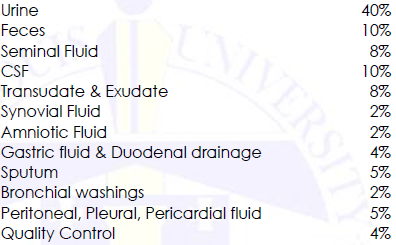
6.1.1 Urine 40%
6.1.2 Feces 10%
6.1.3 Seminal Fluid 8%
6.1.4 CSF 10%
6.1.5 Transudate & Exudate 8%
6.1.6 Synovial Fluid 2%
6.1.7 Amniotic Fluid 2%
6.1.8 Gastric fluid & Duodenal drainage 4%
6.1.9 Sputum 5%
6.1.10 Bronchial washings 2%
6.1.11 Peritoneal, Pleural, Pericardial fluid 5%
6.1.12 Quality Control 4%
Assigned percentage per given unit of a Board subject: Clinical Microscopy
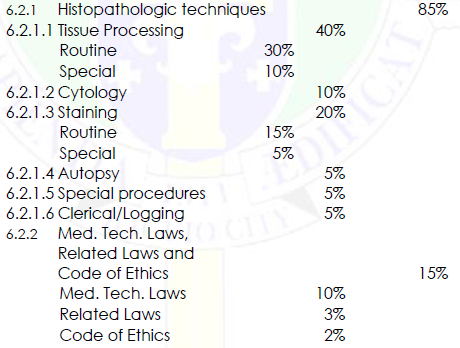
6.2.1 Histopathologic techniques 85%
6.2.1.1 Tissue Processing 40%
Routine 30%
Special 10%
6.2.1.2 Cytology 10%
6.2.1.3 Staining 20%
Routine 15%
Special 5%
6.2.1.4 Autopsy 5%
6.2.1.5 Special procedures 5%
6.2.1.6 Clerical/Logging 5%
6.2.2 Med. Tech. Laws,
Related Laws and
Code of Ethics 15%
Med. Tech. Laws 10%
Related Laws 3%
Code of Ethics 2%
Assigned percentage per given unit of a Board subject: Histopathologic techniques, Med. Tech. Laws, Related Laws & Code of Ethics
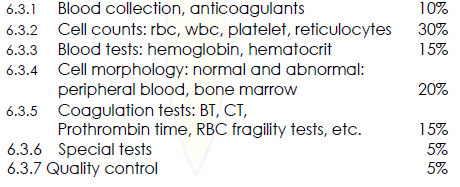
6.3.1 Blood collection, anticoagulants 10%
6.3.2 Cell counts: rbc, wbc, platelet, reticulocytes 30%
6.3.3 Blood tests: hemoglobin, hematocrit 15%
6.3.4 Cell morphology: normal and abnormal: peripheral blood, bone marrow 20%
6.3.5 Coagulation tests: BT, CT,
Prothrombin time, RBC fragility tests, etc. 15%
6.3.6 Special tests 5%
6.3.7 Quality control 5%
Assigned percentage per given unit of a Board subject: Hematology
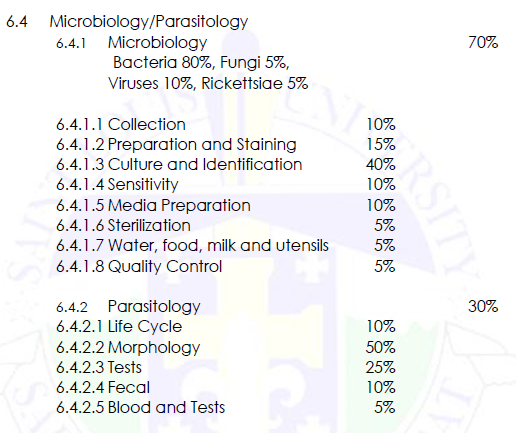
6.4.1 Microbiology 70%
Bacteria 80%,
Fungi 5%,
Viruses 10%,
Rickettsiae 5
6.4.1.1 Collection 10%
6.4.1.2 Preparation and Staining 15%
6.4.1.3 Culture and Identification 40%
6.4.1.4 Sensitivity 10%
6.4.1.5 Media Preparation 10%
6.4.1.6 Sterilization 5%
6.4.1.7 Water, food, milk and utensils 5%
6.4.1.8 Quality Control 5%
6.4.2 Parasitology 30%
6.4.2.1 Life Cycle 10%
6.4.2.2 Morphology 50%
6.4.2.3 Tests 25%
6.4.2.4 Fecal 10%
6.4.2.5 Blood and Tests 5%
Assigned percentage per given unit of a Board subject: Microbiology/Parasitology
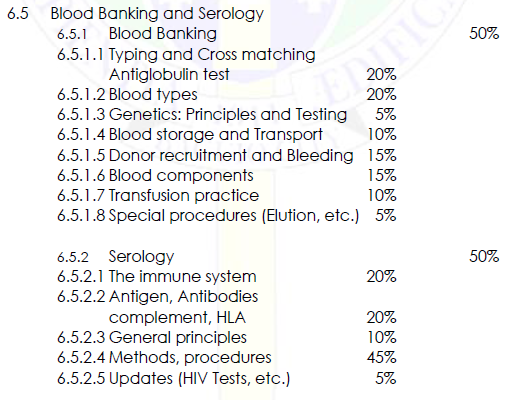
6.5.1 Blood Banking 50%
6.5.1.1 Typing and Cross matching Antiglobulin test 20%
6.5.1.2 Blood types 20%
6.5.1.3 Genetics: Principles and Testing 5%
6.5.1.4 Blood storage and Transport 10%
6.5.1.5 Donor recruitment and Bleeding 15%
6.5.1.6 Blood components 15%
6.5.1.7 Transfusion practice 10%
6.5.1.8 Special procedures (Elution, etc.) 5%
6.5.2 Serology 50%
6.5.2.1 The immune system 20%
6.5.2.2 Antigen, Antibodies
complement, HLA 20%
6.5.2.3 General principles 10%
6.5.2.4 Methods, procedures 45%
6.5.2.5 Updates (HIV Tests, etc.) 5%
Assigned percentage per given unit of a Board subject: Blood Banking and Serology
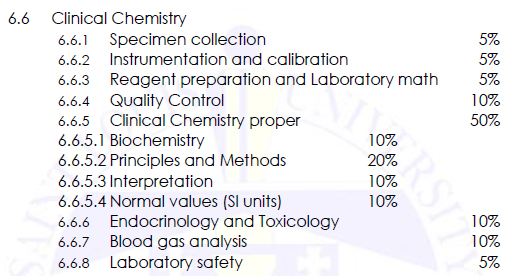
6.6.1 Specimen collection 5%
6.6.2 Instrumentation and calibration 5%
6.6.3 Reagent preparation and Laboratory math 5%
6.6.4 Quality Control 10%
6.6.5 Clinical Chemistry proper 50%
6.6.5.1 Biochemistry 10%
6.6.5.2 Principles and Methods 20%
6.6.5.3 Interpretation 10%
6.6.5.4 Normal values (SI units) 10%
6.6.6 Endocrinology and Toxicology 10%
6.6.7 Blood gas analysis 10%
6.6.8 Laboratory safety 5%
Assigned percentage per given unit of a Board subject: Clinical Chemistry
at least three (3) months prior to the date of examination
Changes to the board exam percentages are to be published when? (Section 17, R.A. 5527)
75%
No rating below 50% in all major subjects
Not have failed 60% of the subjects
Passing grade in examination
No re exam (R.A. 5527; Sections 19: Rating in the Examination)
What will happen if you fail for the third time in the board exam but you are a graduate of paramedical professions other than Bachelor of Science in Medical Technology/Bachelor of Science in Hygiene?
PRC Resolution No. 1 s. 2001, Rule V
It preserves the integrity of the licensure examination by providing the penalties for manipulation and other corrupt practices of professional examinations.
Imprisonment: 6 years and 1 day < > 12 years
Fine P50,000< > P100,000
Both
Punishment for any person who manipulates or rigs licensure examination results, secretly informs or makes known licensure examination questions prior to the conduct of the examination, or tampers with the grades in professional licensure examination
Removed from office and
Perpetual absolute disqualification from public office in addition to the penalties prescribed in Section 15 (a) of RA 8981
Punishment for the offender being an officer or employee of the Commission or a member of the regulatory board
Imprisonment: 4 years and 1 day <> 6 years
Fine: P20,00 <> P49,000
Both
Punishment for Accomplices
Imprisonment: 2 years and 1 day <> 4 years
Fine: P5,000 <> P19,000
Both
Punishment for Accessories
R.A. 5527; Sections 20: Oath Taking
(Act : Section) All successful examinees shall be required to take a professional oath before the Board or before any person authorized to administer oaths prior to entering upon the practice of medical technology in the Philippines.
R.A. 5527; Sections 21: Issuance of Certificate of Registration
(Act : Section) Registration and Licensing Services
21
Age where the certificate of Registration is given.
Signed by:
Members of the Board
Commissioner of the Professional Regulation Commission
Required to display his certificate of registration in the place where he works
All certificates shall be:
Standard is the same
In practice of Med Tech for 3 years in laboratories in the Philippines duly accredited by the Bureau of Research and Laboratories, Department of Health
In practice of Med Tech for 3 years in Foreign countries if before June 21, 1969, all other persons who having graduated from other professions have been actually performing medical technology practice for the last eight (8)
Requirements of a Foreigner for a certificate of registration as medical technologist without examination.
Passed the civil service examination for medical technician given March 21, 1964
Finished a 2-year college course and has at least 1 year experience as med lab technician; Provided, that for every year of deficiency in college attainment two years of experience may be substituted; Provided, further, that an applicant who has at least 10 years of experience as medical laboratory technician as of the approval of the decree regardless of his academic attainment may qualify for registration without examination
Failed to pass the board examination for medical technology but had obtained a general rating of at least 70%.
Issuance of certificate of registration as medical laboratory technician without examination.
R.A. 5527, Sections 23
(Act : Section) Refusal to issue Certificate
R.A. 5527, Sections 23: Foreign Reciprocity
(Act : Section) No foreigner shall be admitted to examination, or be given a certificate of registration or be entitled to any of the rights and privileges under this Act, unless the country or state of which he is a subject or citizen permits Filipino Medical Technologist to practice within its territorial limits on the same as the subject or citizens of said country or state
Name
Address
Citizenship
Date of Registration
Date of Issuance of Certificate
What is in the roster of Medical Technologist?
R.A. 5527, Sections 28
(Act : Section) Roster of Medical Technologist
(R.A. 5527, Sections 24 – 26, 29)
(Act : Section) Legal and other Regulatory Services
R.A. 2382
Medical Act of 1959